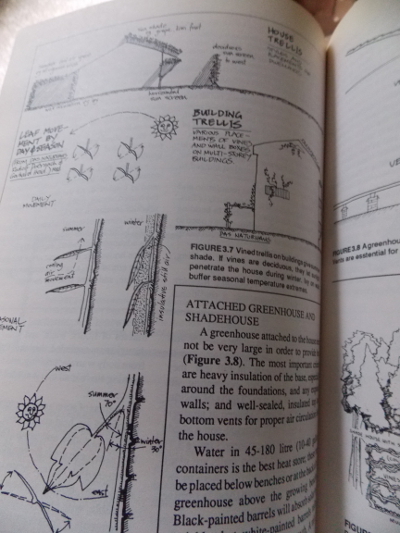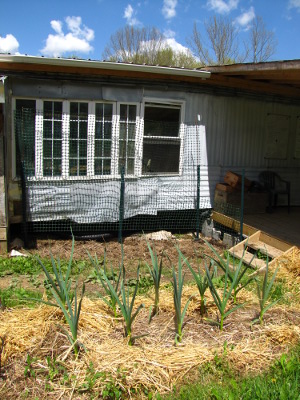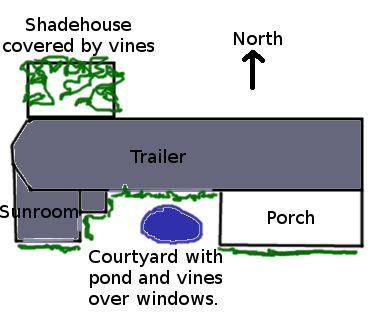
Changing house temperatures with plants
 Of course, the tips from
Mollison's book that I'm most likely to put into action pertain to
plants and ecosystems. I especially enjoyed the way Mollison
suggested alternative uses for features I'd already
considered. For example, I tend to deal with my boggy ground
by building up so I can plant there, but perhaps I should instead
dig out some areas to create open water. (The swamp downhill
from the East Wing might be a good location for
bog-to-shallow-pond experimentation.) And Mollison suggests
considering hedges to be mulch sources and weed barriers as well
as animal barriers and producers of food.
Of course, the tips from
Mollison's book that I'm most likely to put into action pertain to
plants and ecosystems. I especially enjoyed the way Mollison
suggested alternative uses for features I'd already
considered. For example, I tend to deal with my boggy ground
by building up so I can plant there, but perhaps I should instead
dig out some areas to create open water. (The swamp downhill
from the East Wing might be a good location for
bog-to-shallow-pond experimentation.) And Mollison suggests
considering hedges to be mulch sources and weed barriers as well
as animal barriers and producers of food.
Meanwhile, Mollison
goes into depth about using plants to mitigate heating and cooling
 issues around your
home. While deciduous shade trees are great, we just don't
have room for such a large plant on the south side of our trailer
--- a maple would take up half the garden (and would impact the
powerline). But I've been planning to trellis vines against
the south side of the porch and trailer instead, and Mollison
heartily approves of the idea. My
first attempt this spring with annual vines failed because
it turns out that the soil there is very wet and clayey, so I'm
dumping masses of weeds in the spot this summer to raise the soil
up and increase the organic matter content in preparation for fall
planting of some kind of perennial vine (probably home-propagated
grapes).
issues around your
home. While deciduous shade trees are great, we just don't
have room for such a large plant on the south side of our trailer
--- a maple would take up half the garden (and would impact the
powerline). But I've been planning to trellis vines against
the south side of the porch and trailer instead, and Mollison
heartily approves of the idea. My
first attempt this spring with annual vines failed because
it turns out that the soil there is very wet and clayey, so I'm
dumping masses of weeds in the spot this summer to raise the soil
up and increase the organic matter content in preparation for fall
planting of some kind of perennial vine (probably home-propagated
grapes).
On a related note,
did you know that hanging plants are supposed to cool the
surrounding area? I'd always thought the pots of dangling
ferns I notice in southern homes and porches are just for
aesthetics, but I can see how the plants might do their part in
keeping conditions comfortable nearby. Similarly, all those
fountains in Mediterranean countries are meant to add humidity
(and thus coolness) to the air, while ivy growing over buildings
is reputed to reduce heat  gain in the summer by 70%
and heat loss in the winter by 30% --- homegrown insulation!
Finally, a courtyard pond can buffer heat both during the summer
and the winter.
gain in the summer by 70%
and heat loss in the winter by 30% --- homegrown insulation!
Finally, a courtyard pond can buffer heat both during the summer
and the winter.
While I'm unlikely to
put all of these ideas into action right away (or maybe ever), I
couldn't help mocking up a design for the truly integrated
permaculture trailer. With the help of a few plants, we
might make our singlewide even more livable over time.
| This
post is part of our Mollison's
Introduction to Permaculture lunchtime series.
Read
all of the entries: |
Want more in-depth information? Browse through our books.
Or explore more posts by date or by subject.
About us: Anna Hess and Mark Hamilton spent over a decade living self-sufficiently in the mountains of Virginia before moving north to start over from scratch in the foothills of Ohio. They've experimented with permaculture, no-till gardening, trailersteading, home-based microbusinesses and much more, writing about their adventures in both blogs and books.
Want to be notified when new comments are posted on this page? Click on the RSS button after you add a comment to subscribe to the comment feed, or simply check the box beside "email replies to me" while writing your comment.

Anna, one year I grew green beans against the south(ish) side of my house. I hung twine from the eaves of my roof (held in place with a small nail), and trained green and purple snap beans up the twine. It worked beautifully... until the bean vines climbed past my 12' roof. Everyone thought it was hilarious, especially when I had to climb the 10' ladder with a bucket to harvest beans twice a week
I did a similar experiment with a lower roof and Christmas limas - worked better because instead of having to pick beans frequently, I just let them mature and dry in place. Then at the end of the summer when they started looking ratty, I pulled down the bean vine and harvested the now-dried beans. Course, this is dry CA, not sure if that would work in your area.